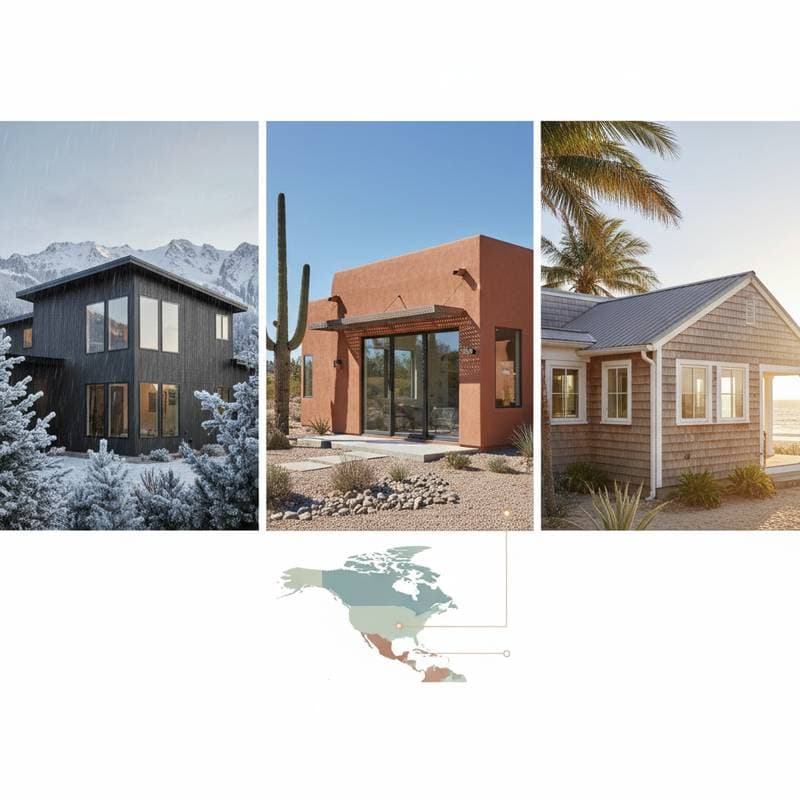Climate Zones That Change Your Siding Choice
Selecting siding for a home requires careful consideration of local climate conditions. Different zones present unique challenges, such as extreme cold, intense heat, high humidity, or coastal exposure. Materials must withstand these elements to ensure durability, energy efficiency, and long-term value. This guide explores how climate influences siding decisions, highlights suitable options, and provides practical strategies for installation and upkeep.
Homeowners in varied regions benefit from tailoring choices to environmental demands. For instance, northern areas demand insulation against freezing temperatures, while southern locales prioritize heat reflection. Proper selection enhances curb appeal and protects investments over decades.
Understanding Key Climate Zones
Climate zones divide the United States into categories based on temperature, precipitation, and weather patterns. The Department of Energy outlines several primary zones, each dictating siding performance needs. Awareness of your zone guides material selection for optimal protection and efficiency.
Cold Climates (Zones 5-7)
Regions with harsh winters, like the Midwest and Northeast, experience sub-zero temperatures and heavy snow. Siding here must resist cracking from freeze-thaw cycles and provide thermal barriers. Fiber cement and insulated vinyl excel in these conditions, offering robust insulation values that reduce heating costs.
Installation in cold zones involves securing panels tightly to prevent wind infiltration. Costs range from $8 to $15 per square foot for fiber cement, with ROI through energy savings averaging 20 percent over 20 years. These materials maintain structural integrity, minimizing repairs from ice dams or moisture buildup.
Hot and Dry Climates (Zones 2-3)
Southwestern deserts feature scorching days and cool nights, leading to material expansion and contraction. Siding selections focus on UV resistance and low thermal absorption. Metal siding, such as aluminum or steel, performs well, reflecting heat and enduring sun exposure without fading.
Expect installation expenses of $7 to $12 per square foot, yielding high ROI via reduced cooling needs. Pair metal with reflective coatings for added efficiency. These options withstand dust storms and dry winds, preserving appearance and functionality.
Humid and Subtropical Climates (Zones 3-4)
Southeastern states battle high moisture, mold risks, and hurricanes. Siding requires water resistance and ventilation to avoid rot. Engineered wood or hardie plank fiber cement suits these areas, with treatments that repel insects and fungi.
Pricing falls between $9 and $14 per square foot, with strong ROI from storm resilience. Proper venting during installation prevents trapped humidity. These materials support humidity levels up to 90 percent without degradation.
Coastal Climates (Zones 3-5)
Oceanfront locations face salt spray, high winds, and erosion. Corrosion-resistant options like PVC or cedar with protective finishes prove ideal. They endure saline air and tidal surges, maintaining integrity against abrasive elements.
Installation costs $10 to $16 per square foot, but ROI shines through minimal upkeep in salty environments. Select marine-grade fasteners to secure panels. Such choices safeguard homes from gradual coastal wear.
Material Performance and Regional ROI
Each climate zone influences not only durability but also return on investment. In cold areas, insulated siding cuts energy bills by up to 15 percent annually. Hot zones benefit from cool-roof materials that lower air conditioning demands.
Humid regions see value in mold-resistant panels that extend lifespan to 40 years. Coastal selections resist fading, boosting resale by 5 to 10 percent. Factor in local labor rates and material availability when budgeting; national averages hover at $10,000 to $25,000 for full-home applications.
Compare warranties: Vinyl offers 30-year coverage in mild climates, while metal extends to lifetime in dry zones. Align choices with zone-specific building codes for compliance and incentives.
Design Principles for Siding Success
Beyond climate suitability, design elements enhance siding effectiveness and aesthetics. Proportion plays a key role in visual balance. Use horizontal lines to elongate low homes and vertical boards to lift tall facades.
Maintain contrast between siding and trim in the medium range for balanced photos and visibility. Select entry materials that resist grime, since this area sets first impressions. Update lighting and house numbers while walls are open to wiring adjustments.
Color undertones matter greatly. Cool grays pair well with metal or stone in northern climates. Warm beige or tan complements desert or coastal light. Avoid mixing too many hues across elevations.
Takeaway: Curb appeal grows from proportion and restraint. A clean layout with consistent shadow lines photographs better and supports resale confidence.
Maintenance and Longevity
Routine care extends siding lifespan and stabilizes ownership costs. Most materials last 20 to 50 years when cleaned and sealed correctly. Adapt schedules to climate demands, such as more frequent rinses in humid areas.
Maintenance checklist:
- Spring: Rinse siding with low-pressure water. Check caulk joints and repaint bare spots.
- Fall: Clear gutters and inspect flashing for gaps. Trim vegetation touching walls.
- Every 3 years: Pressure wash fiber cement or vinyl using a soft brush.
- Every 5 to 10 years: Recoat painted surfaces depending on exposure.
Cleaning tools: Use mild soap, a soft brush, and a garden hose. Avoid harsh chemicals that strip finishes. Never use high-pressure washers on seams or joints.
Warranty notes: Most siding warranties cover manufacturing defects, not installation errors. Keep records of contractor certification and paint batch codes to preserve coverage.
Takeaway: Consistent cleaning and inspection reduce repainting frequency and protect resale value through visible upkeep.
Securing Long-Term Benefits
Siding that fits its climate zone resists damage, keeps maintenance predictable, and supports steady resale value. The right combination of profile, color, and detailing turns weather resistance into visual strength. Whether planning for heat, moisture, or cold, align each material decision with local conditions and proven installation standards.
Professional assessment ensures precision, from site evaluation to final touches. This approach not only withstands environmental pressures but also elevates home equity. Invest thoughtfully to enjoy enduring protection and appeal.

